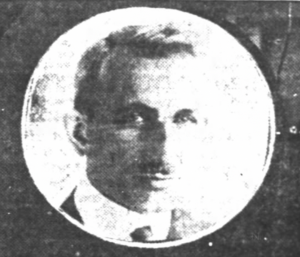
(Feb. 21, 1891-Sept. 3, 1960). Francis F. Hamilton was the son of Lucius Hamilton, a founder of the Hamilton-Harris Company of Indianapolis (wholesaler of tobacco and sundry goods). He learned about radio while earning an electrical engineering degree at Purdue University. The school partnered with the U.S. Army Signal Corps in the instruction of radio operators during World War I. Hamilton became part of the program and in the process completed what was considered to be an advanced and efficient long-range receiver.
Francis F. Hamilton is credited with getting the first Indianapolis radio station on the air on election night in November 1920. The station signed on as 9ZJ () from Hamilton’s garage at 2011 North Alabama Street. On New Year’s eve of 1921, Hamilton invited a few friends, including Mayor Lew Shank, to join him in greeting the new year with a wireless salute. That same night also produced what was probably the city’s first remote broadcast. Hamilton installed an ordinary telephone receiver on the stage of B. F. Keith’s Grand Opera House, a vaudeville theater which previously had been the Park Theater, at 115 Pennsylvania Street in downtown Indianapolis. It provided listeners with the sound of vaudeville acts appearing there at the time.
In 1922, the Indianapolis News joined forces with Hamilton in his new broadcast venture, with the latest equipment installed on the tenth floor of the newspaper’s office building on West Washington Street. Programming included concerts by the News’ Glee Club and the Newsboys’ Band and readings by News feature writer William Herschell. A few weeks later, at the insistence of the U.S. Department of Commerce, the station became WLK.
Hamilton expanded his operation when joined him in April 1922. WLK became the Ayres-Hamilton station. Ayres opened a radio room that offered the latest radio sets and spare parts and provided records that could be played and promoted.
By 1923, the enthusiasm waned. Expenses exceeded income, which apparently went primarily to Ayres. Surprisingly, Hamilton was not charging for airtime. In an effort to raise money, he tried to interest 5,000 Hoosiers in subscribing to a proposed magazine for $3 a year but did not get enough response, and WLK folded. The city’s first fling with broadcasting was over, as was Hamilton’s involvement as a broadcast entrepreneur.

Help improve this entry
Contribute information, offer corrections, suggest images.
You can also recommend new entries related to this topic.